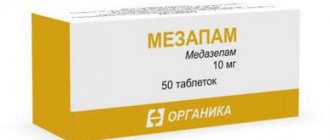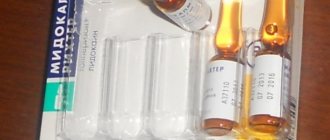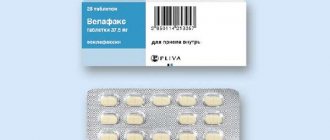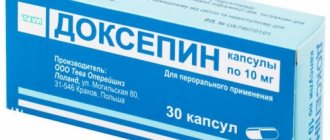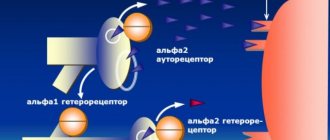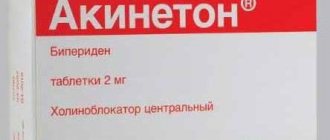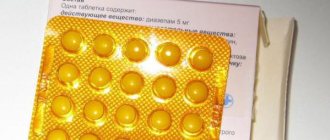pharmachologic effect
Difenin is a drug with anticonvulsant, muscle relaxant, analgesic and antiarrhythmic activity. The active ingredient is a derivative of hydantoin.
The anticonvulsant effect is achieved due to membrane stabilization of synapses, axons and neurons, as well as by limiting the spread of seizure activity and excitation.
The active component is characterized by an exciting effect on the cerebellum, which is achieved through the activation of inhibitory pathways that extend to the cerebral cortex. The opposite effect may also occur (decreased convulsive activity), which is associated with an increased effect of discharges in the cerebellum.
The antiarrhythmic effect is achieved due to membrane stabilization in the cells of Purkenje fibers. The active substance is capable of blocking sodium transmembrane current and reducing the level of cell permeability to calcium ions.
During treatment, there is a decrease in abnormal ventricular excitability and automaticity. The drug leads to a widening of the QRS complex on the ECG and a shortening of the refractory period.
For neuralgia
trigeminal nerve, there is an increase in the threshold of pain sensitivity, a decrease in excitation, a decrease in the number of repeated discharges, and a reduction in the number of attacks.
The muscle relaxant mechanism of action is similar to the mechanism of anticonvulsant activity: membrane stabilization in motor disorders reduces the severity and duration of repeated discharges (potentiation in muscle and nerve cells is additionally weakened).
The active substance is capable of inducing microsomal enzymes in the liver, which leads to increased metabolism
medications used simultaneously with Phenytoin.
Indications and contraindications
Most often, Difenin is prescribed for epilepsy with generalized convulsive seizures, epi-status, and for seizures after neurosurgical treatment. Also prescribed for preventive purposes after traumatic brain injuries. As an addition to the main treatment for trigeminal neuralgia, it helps reduce the intensity of pain and allows you to reduce the dose of analgesics.
Trigeminal neuralgia
In cardiology, Difenin is prescribed in the presence of ventricular arrhythmias caused by organic lesions of the central nervous system, in case of overdose of digoxin and other cardiac glycosides. In otolaryngology, it is prescribed for the treatment of Meniere's syndrome - a lesion of the inner ear of non-inflammatory etiology.
This drug is prohibited for use in people with the following cardiac diseases:
- sinus bradycardia;
- atrioventricular block;
- Morgagni-Adams-Stokes syndrome;
- weakness of the sinus node;
- acute heart failure.
Morgagni-Adams-Stokes syndrome
Diphenin has a toxic effect on the liver, therefore it is contraindicated in persons with hepatitis and cirrhosis. If you have porphyria, cachexia, or chronic kidney disease, you should also avoid treatment with these tablets.
The use of this anticonvulsant should be under special supervision in children with signs of rickets, the elderly, people suffering from diabetes mellitus and alcoholism. Phenytoin penetrates well through the uteroplacental barrier and into breast milk, which precludes its use in pregnant and breastfeeding women. Age limit: children under 5 years old.
Pharmacodynamics and pharmacokinetics
Diphenin is characterized by slow absorption from the digestive system. The active substance is able to penetrate into bile
, saliva, cerebrospinal fluid, intestinal juice, sperm, breast milk,
gastric juice
. When passing through the placental barrier, the concentrations of phenytoin in the fetal plasma and maternal blood are equalized.
The main metabolism is in the hepatic system with the participation of isoenzymes. The formed metabolites are inactive. When therapeutic concentrations are reached, the enzyme system becomes saturated, which indicates the body’s ability to metabolize only a certain amount of the active substance.
Accordingly, as the dosage increases, there is a disproportionately significant increase in the concentration of Phenytoin. The half-life also increases. The drug is excreted primarily through the renal system, partially through the intestines in the form of metabolites.
Side effects
Musculoskeletal system:
- peripheral polyarthropathy;
- Dupuytren's contracture;
- rickets
and
osteomalacia
(develop in the absence of adequate intake of vitamin D into the body).
Metabolism:
- development of hypocalcemia;
- vitamin D
metabolism ; - Impaired glucose uptake (due to inhibition of insulin
).
Allergic responses
:
- fever;
- epidermal toxic necrolysis;
- drug-induced lymphadenopathy;
- skin rashes;
- eosinophilia.
Endocrine system:
- extension of the lower jaw;
- hypertrichosis;
- expansion of the tip of the nose;
- thickening of lips;
- enlargement of facial features.
Digestive tract:
- liver damage;
- nausea;
- gum hyperplasia;
- vomit;
- gingivitis;
- hepatitis of toxic origin;
- constipation
.
Nervous system:
- muscle weakness;
- nystagmus;
- hand trembling;
- dizziness;
- mood instability;
- confusion;
- ataxia;
- sleep disorders
; - peripheral neuropathy;
- transient nervousness;
- impaired coordination of movements.
Hematopoietic system:
- pancytopenia;
- leukopenia;
- thrombocytopenia;
- megaloblastic anemia;
- granulocytopenia.
In rare cases, Peyronie's disease develops.
Side effects
If Difenin was prescribed, side effects are possible. They mainly appear when the drug is used incorrectly. Among the side effects of phenytoin, the instructions for use note:
- dizziness;
- megaloblastic anemia;
- excitation;
- hypocalcemia;
- tremor;
- osteopathy;
- ataxia;
- gum hyperplasia (mainly observed in patients under the age of 23);
- fever;
- allergic reactions on the dermis;
- nausea;
- coarsening of facial features, etc.
From the gastrointestinal tract, the following may be observed: toxic hepatitis, loss of appetite, disturbances in liver function.
If you use the drug for a long time, sensory polyneuropathy may develop.
From the senses and nervous system the following are observed: unpleasant sensations in the eyes, irritability for no reason, lack of coordination.
Weight loss may also occur. Allergic reactions include: toxicoderma, exfoliative dermatitis.
From the circulatory system, the following may occur: agranulocytosis, leukopenia, aplastic anemia.
The instructions for use contain a warning that if you suddenly stop taking the drug, withdrawal symptoms may occur. Very rarely, peripheral neuropathy and Peyronie's disease are observed. People suffering from diabetes may experience hyperglycemia.
Important! If side effects occur, you should either stop taking the drug or reduce its dose.
Instructions for Difenin (Method and dosage)
For adults, the initial dosage is calculated according to the scheme 3-4 mg/kg/day. Subsequently, the amount of the drug is increased until the optimal therapeutic result is achieved.
Most often, the maintenance dose is 200-500 mg per day (one time or in several doses).
Instructions for use of Diphenin for children
The initial dose is calculated according to the scheme 5 mg/kg/day. The maximum daily amount is 300 mg. The maintenance daily dose is 4-8 mg/kg.
Instructions for use
Diphenine is usually prescribed in a course of no more than 4 tablets per day. Results will be visible only after 4 days. As soon as the effect appears, the dose is reduced to 3 tablets. These instructions for use are used for arrhythmia.
Dosage
To achieve quick results, it is recommended to follow a specially designed scheme:
- On the first day you should take 1 tablet 4 times a day.
- The same must be repeated on the second, third and fourth days.
- On day 5, the dose is reduced to 3 tablets.
If you need the fastest possible therapeutic effect, clinical instructions for use on the first day suggest taking 2 tablets of the substance 4 times. On days 2–3 - one tablet 5 times. From the fourth day - 1 tablet 2 times a day.
Important Notes
To avoid an allergic reaction, Difenin is taken before or after meals. Also, when used according to the instructions, the drug is not used together with alcohol, otherwise the content of phenytoin in the blood increases.
If after taking the drug your kidney and liver function suffers, you should consult a specialist. He will change the dosage.
The drug is contraindicated for pregnant women, as reflected in the instructions for use. However, in clinical practice it is prescribed in cases where there is a danger to life. After childbirth, there may be a deterioration in blood clotting.
The drug is not prescribed to nursing mothers. It passes into breast milk and has a bad effect on the baby's health.
With long-term drug therapy, you will need to follow a special diet. It should be aimed at replenishing vitamin D. It will also be necessary to compensate for the lack of UV radiation.
The instructions for use draw attention to the fact that treatment with Diphenin in children during their growth period can provoke the development of disorders in the connective tissue. As for driving a car, the drug can reduce the speed of psychomotor reactions.
Interaction
Medicines, the simultaneous use of which increases the severity of side effects and the therapeutic effect of Difenin:
- Trazodone;
- sulfonamides;
- estrogens;
- Fluconazole;
- Metronidazole;
- Amphotericin B;
- Isoniazid;
- Diazepam;
- chloramphenicol;
- Omeprazole.
Phenytoin can alter the therapeutic effect of the following drugs:
- Rifampicin;
- Doxycycline;
- antifungal medications;
- glucocorticosteroids;
- oral contraceptives;
- Quinidine;
- Furosemide.
The depressant effect on the nervous system is enhanced by the simultaneous use of medications that suppress brain activity.
Medicines that can change the concentration of phenytoin in the blood plasma:
- antitumor drugs;
- phenothiazine derivatives (Thioridazine, Chlorpromazine);
- Phenobarbital.
It is impossible to predict the effect of the active substance on the level of Phenobarbital in the blood plasma. Acyclovir can reduce the level of Phenytoin in the blood, which may lead to a decrease in the effectiveness of Diphenin. Treatment with Valproic acid
leads to an increase in the level of the active substance in the blood, especially in the first weeks of therapy.
With subsequent inhibition of metabolism, plasma levels of phenytoin increase. The medication reduces the level of Felodipine, Verapamil
and
Nimodipine
in blood plasma. The therapeutic effect is lost with simultaneous treatment:
- Vigabatrin;
- Reserpine;
- Folic acid;
- Carbamazepine;
- sucralfate.
Mutual inhibition of activity is recorded with simultaneous administration of Theophylline
.
special instructions
In patients suffering from individual intolerance
anticonvulsant hydantoin drugs, hypersensitivity to Diphenin is recorded.
If treatment is abruptly stopped, patients with epilepsy may develop withdrawal syndrome
.
If there is an urgent need to discontinue the medication, it is recommended to prescribe other anticonvulsants that are not hydantoin derivatives. The active substance undergoes active metabolism in the hepatic system, therefore, persons with liver diseases and elderly patients are advised to adjust the dosage regimen individually.
Be sure to eat foods rich in vitamin D throughout the entire treatment period. Ultraviolet radiation has a positive effect. In children during the growth period, while taking Phenytoin, connective tissue diseases develop.
For chronic alcoholism
the concentration of the active substance decreases, and in case of acute alcohol intoxication it increases. A slowdown in psychomotor reactions is characteristic, which must be taken into account in patients whose work involves driving vehicles.
Analogs
If the patient has been prescribed Difenin, its analogues may also be useful for therapy. In some cases, doctors prescribe medications such as:
- Disopyramide;
- Lidocaine;
- Mexiletine;
- Difantoin.
Disopyramide improves arteriolar tone. Lidocaine is used to treat ventricular arrhythmias, but is not used to treat atrial fibrillation. It is perfect for people suffering from hypotension.
Mexiletine gives a long-lasting effect. Excellent help with ventricular extrasystole.
Difantoin is used for supraventricular and ventricular cardiac arrhythmias. It is suitable for the treatment of ventricular arrhythmia, its prevention, bradyarrhythmia, trigeminal neuralgia.
Diphenini during pregnancy and lactation
It is inadmissible to use the medication during pregnancy
. According to studies, Phenytoin provokes the growth of tumors (including neuroblastomas). In children whose mothers took the medication during pregnancy, cleft palate and upper lip are most often reported.
The active substance is released during breastfeeding
in sufficient quantities to cause the development of negative reactions in infants. Phenytoin is contraindicated during lactation.


